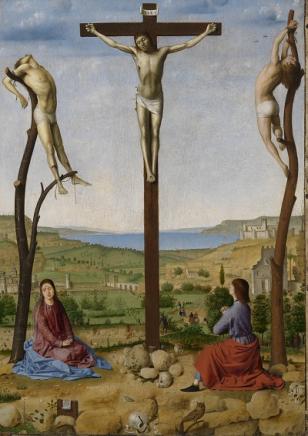This archived website 'Flemish primitives' is temporarily not being updated. Certain functionality (e.g. specific searches in the collection) may no longer be available. News updates about the Flemish primitives will appear on vlaamsekunstcollectie.be. Questions about this website? Please contact us at info@vlaamsekunstcollectie.be.
The Calvary restored
The conservation treatment of Antonello da Messina's the Calvary for the Royal Museum of Fine Arts Antwerp (KMSKA) has been completed. The painting is a great piece by this Italian Renaissance master, just forty-six of whose works survive worldwide. Susan Farnell, a conservator with many years of experience, described the conservation project as her toughest assignment yet. The heavy overpainting could only be removed mechanically, with scalpel and microscope.
Antonello da Messina (1430-1479) is one of the most important artists of the Italian Quattrocento. Inspired by Early Netherlandish art, he perfected the technique of oil painting.Today, just forty-six works by Antonello's hand survive, and they are scattered around the globe. The Royal Museum is the proud owner of the Calvary, one of Antonello's main works. The panel was bequeathed to KMSKA in 1841 by the former Antwerp mayor and great art collector Florent van Ertborn. It is the only work by Antonello to be preserved in Belgium and has been listed under a decree for the protection of exceptional art treasures.
Antonello painted the Calvary in 1475. The work is signed and dated, so that its attribution is beyond question. In 2006, it featured as one of the highlights of the monographic exhibition at the Scuderie del Quirinale in Rome. After the exhibit it was decided that this important masterpiece should undergo conservation treatment.
KMSKA called on the expertise of Susan Farnell for this delicate assignment. Farnell has an impressive track record of successful conservation work, which includes treatments of Portrait of a Man with a Roman Coin by Hans Memling and The Prodigal Son by Peter Paul Rubens. "I have worked in this field for many years, but this was my toughest assignment yet! The treatment was complex, because much of the overpainting had to be removed mechanically."
The first step in the restoration process was the treatment of the wooden support. Farnell removed the dark layer of varnish and the overpainting, which covered large parts of the original paint layer. This was the most challenging and time-consuming phase of the project: as the overpainting was resistant to solvents, it had to be painstakingly removed with scalpel and microscope, millimetre by millimetre. This work uncovered further problems. The poplar panel had been affected by woodworm, so that some areas had become fragile or even damaged. Fortunately, though, the original paint layer was found to be in much better condition than presumed. Hence the result of the conservation treatment is nothing short of spectacular. "The painting has become very bright. It has gained depth and the fabulous details ares now as visible!", says Susan Farnell.
The conservation treatment of the Calvary was started in June 2008 and was only concluded in January 2011. An international committee of experts monitored the entire process. The painting was also examined by University Antwerp, the European mobile laboratory MOLAB and INOA (Istituto Nazionale de Ottica Applicata-CNR). Preparations are now underway for the work to be reframed.
The Calvary has been selected for the exhibition Masterpieces in the MAS. Five Centuries of Imagery in Antwerp, where the public will be able to admire it in its original splendour for the very first time.







